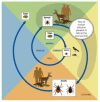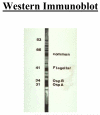Lyme disease
- PMID: 20513553
- PMCID: PMC3652387
- DOI: 10.1016/j.cll.2010.01.003
Lyme disease
Abstract
Lyme disease, caused by the spirochete Borrelia burgdorferi, is the most common vector-borne disease in the United States. The clinical presentation varies depending on the stage of the illness: early disease includes erthyma migrans, early disseminated disease includes multiple erythema migrans, meningitis, cranial nerve palsies, and carditis; late disease is primarily arthritis. The symptoms and signs of infection resolve in most patients after treatment with appropriate antimicrobials for 2 to 4 weeks. Serologic testing should be used judiciously as it often results in misdiagnosis when performed on blood from patients with a low prior probability of disease and those with only nonspecific symptoms such as fatigue or arthralgia without objective signs of infection.
2010 Elsevier Inc. All rights reserved.
Figures










References
-
- Shapiro ED, Gerber MA. Lyme disease. Clin Infect Dis. 2000 Aug;31(2):533–542. - PubMed
-
- Centers for Disease Control and Prevention Lyme Disease-United States 2001-20021. MMWR. 2004;53:365–369. - PubMed
-
- Steere AC, Taylor E, McHugh GL, et al. The overdiagnosis of Lyme disease. Jama. 1993 Apr 14;269(14):1812–1816. A. - PubMed
-
- Reid MC, Schoen RT, Evans J, et al. The consequences of overdiagnosis and overtreatment of Lyme disease: an observational study. Ann Intern Med. 1998 Mar 1;128(5):354–362. - PubMed
-
- Nadelman RB, Nowakowski J, Fish D, et al. Prophylaxis with single-dose doxycycline for the prevention of Lyme disease after an Ixodes scapularis tick bite. N Engl J Med. 2001 Jul 12;345(2):79–84. - PubMed
Publication types
MeSH terms
Grants and funding
LinkOut - more resources
Full Text Sources
Other Literature Sources
Medical

